03 Apr Malta — Easter Week in Malta . . . and Tehran
Despite the murder of the occasional investigative journalist, I’ve always thought Malta sounded like a good place to retire.
It’s a sunny, Mediterranean isle that’s just about as close to everywhere in Southern Europe or Northern Africa as a place could get. Want to visit Sicily for the weekend? Hop a ferry. Or Rome? Or Naples? Venice and Marseilles and Lyons and the Balearics, are just over the horizon. Cairo and Tunis and Casablanca, not that much further. And talk about your history. Babylonians and Myceneans and Etruscans, Hittites, Berbers and Tuareg, all an afternoon’s journey by airplane. Phoenicians and Carthaginians, Romans, Greeks. Arabs, Normans, Aragonese, Knights of St John, French and British are inches away because on Malta you can’t so much as stick a spoon in the ground without digging up traces of former regimes.
The oldest megalithic temples in the world are in Malta.
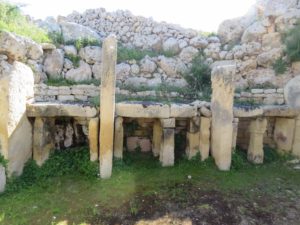
And, on top of that, Malta was center stage for two of the most important sieges ever . . . sieges that, had Malta lost, today’s world would be very different.
Siege Number One took place in 1565 when Suleiman the Magnificent decided to bring the Sword of the Prophet to Europe. But first he had to conquer Malta . . . which he set out to do with 40,000 soldiers and the two gigantic cannon that had blown apart the walls of Constantinople. The reason you don’t bow down five times a day to a meteorite pasted onto the side of the Ka’bah in Mecca is because the 500 Knights of St John and the 6,000 locals, operating, partially, out of Fort St Elmo, refused to give up. When the siege lifted, 5,000 Turks straggled home.
The other history-determining siege occurred during the Second World War. Rommel’s Afrika Korps was withering in Libya because his supply ships kept getting sunk. Three ancient biplanes the British called Faith, Hope, and Charity based on Malta were spotting the German ships. To stop them, the Luftwaffe dropped so much ordnance on the island that, by the end of the war, Fort St Elmo had become the most bombed place on the planet. It wasn’t until thirty years later that the Germans, and everybody else, learned the real reason the convoys were being sunk. The British had broken the German code.
The British never really extracted themselves from the island . . . leaving Queen Elizabeth as head of state in 1974 when Malta joined the Commonwealth as an independent nation. Seven or eight generations of life under British law and British culture means that a lot of good ideas about politics, and good governance, and an independent judiciary stayed behind. . . which, to me, made Malta the ideal place to live. Climate, history, location, English language, decent government. What have I overlooked?
“Grandchildren,” Peggy said. “You have overlooked our grandchildren in Oregon.”
“There are,” I pointed out, “many grandchildren in Malta. Many, many grandchildren.” In fact, when I thought about it, everybody on Malta is a grandchild. Every single one. “Malta is an entire island of grandchildren.”
For somebody who’s usually so open and welcoming of foreign cultures and places, Peggy was surprisingly narrow-minded about Maltese grandchildren.
We did visit, though. Two Holy Weeks ago on our way to Tehran.
Fort St Elmo is still there, still unconquered, looking relaxed and peaceful. It’s an Imperial War Museum now, which is interesting all by itself.
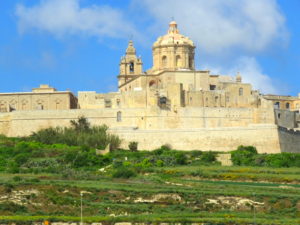
The main city, Valetta, is named for Jean Parisot de Valette, Grand Master of the Knights of St John and, by many accounts not just the savior of Malta, but of Western culture as well.
The Grand Harbor is just about as picturesque as a harbor can get. It’s like Venice, only with better views of the Renaissance buildings constructed along the water’s edge.
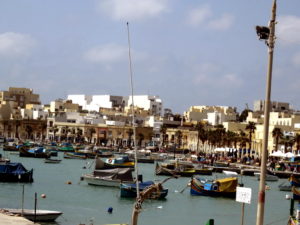
But the real action came on Friday night. Good Friday night, with a parade of bible stories. A parade that must have been repeated hundreds of times on hundreds of Good Fridays. At least it looked that way to me. The costumes weren’t just thrown-together things like you’d pin to a child on Hallowe’en, but appeared to be genuine family heirlooms.
There are a few Roman soldiers in the bible, not many, and they’re all from the New Testament. But, because Roman soldiers sported great-looking uniforms, many of the marchers came as Roman soldiers. Many, many marchers adding up to more Roman soldiers, probably, than garrisoned the island during the time of Augustus.
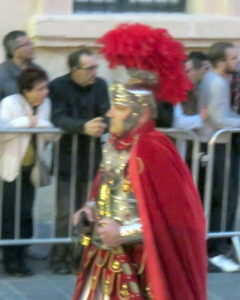
Roman soldiers with horsehair plumes that would have blocked the sun if it had been daytime and the sun had been out.
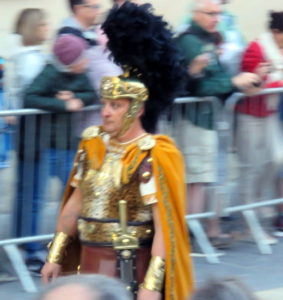
You could imagine the marchers breaking out their family’s Roman-army gear and polishing and waxing and making minor repairs, just as their great-grandfathers had done with the same gear a hundred years before. I’m not scholar enough to know for sure, but I’d win money if you were silly enough to bet against it, that the details were authentic, too. Centurion of the Forward Spears, Legio III (Gallica). Guard Commander, Legio VI, (Ironclad).
It made me wonder what people a couple of thousand years from now would wear if they wanted to dress up like Twentieth Century warriors. Soviet generals, I imagined, loaded with so many medals they’d go straight to the bottom if they fell off a bridge. Or Prince Charles at his silliest. Or North Korean officers with exaggerated hats sticking into the air like Roman horsehair. Or, if the script required Americans, Marine master sergeants – with their black jackets and swords, their white belts and gloves, their gold and red rank insignia, their dark blue pants with the red stripe – would be more common than they are in real life today.
The parade went by in approximate biblical order with a lot of stuff from the Book of Exodus. Pharaohs:
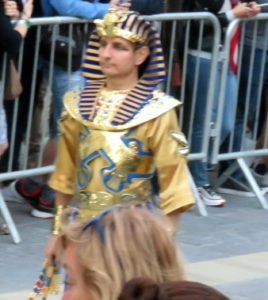
Priests from unspecified religions
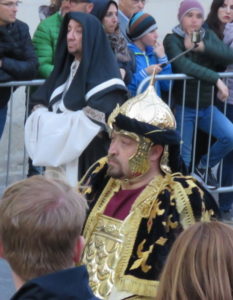
Or, maybe, just a guy who wanted to show off his family’s Genghis Kahn suit.
A gorgeous fellow who may have been a priest of Ba’al escorting a kid to the Tophet to be tossed into the fiery maw of a brazen statue.
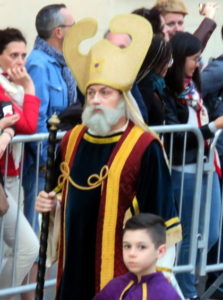
Much later, long after the crowd had thinned, we worked our way to a Nativity scene
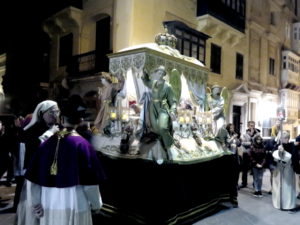
that appeared to have been lifted bodily from a church and looked very heavy, so that the people carrying it had to put it down and rest from time to time.
And, then, through the life, and afterlife, of Jesus. By then it was getting too dark to take pictures so I stopped trying. Besides, the Old Testament stuff was way more interesting.
Somewhere after Thomas has the truth revealed to his doubting eyes, Peg and I headed back toward our room . . . and were intercepted by music, dancing crowds, and Adam and Eve coming down a long hill on the street opposite where we were staying. Somehow, we’d imagined the parade had paraded past where we were watching then gone off to wherever parades go, and that had been that. But not this parade. This parade seemed to go on all night, and along every street in Valetta.
Thirty-six hours later we were in Iran.
Easter Sunday in a park in Tehran, when a claque of schoolgirls
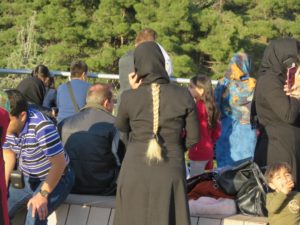
presented me with a scrap of paper, lettered in Farsi. It took some asking, but the paper turned out to be a prayer for the return of the Mahdi. It was his birthday and the girls were celebrating by passing out prayers to park-goers.
The Mahdi, for those not versed in the intricacies of the Shia brand of Islam, is the Occulted Imam who, in the fullness of time, will reveal himself and reign over the Latter Days before the Resurrection. Oddly, given the echoes of Christianity in the story, or fittingly, or eerily, or because of rotating calendars, or for reasons known only to the common god our more ecumenical theologians claim we all share, his birthday fell on Easter Sunday.
To Believers, the Mahdi has already taken a stab at revealing himself. This happened in the 1880’s when he led an uprising in Sudan. But it didn’t stick. He won a spectacular series of battles, then became occulted all over again when he died. His movement fell apart a few years later when his successor in Mahdiship attracted the notice of a British army equipped with Maxim guns and Martini-Henry rifles.
Whether he plans to re-reveal himself anytime soon has not been communicated to me but, whatever he has in mind, there’s not much doubt what those girls were thinking. Their faces were ablaze with the joy and light of the true believer. And the Farsi translated into the kind of notes lovesick schoolgirls pass around in junior high.


No Comments